Gettysburg National Military Park (U.S. National Park Service)
Introduction
Text-to-speech Audio
Images
The Soldiers' Monument in the center of the Soldiers' National Cemetery at Gettysburg
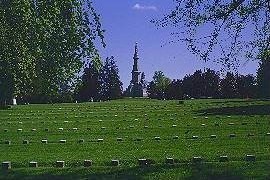
Gettysburg National Military Park
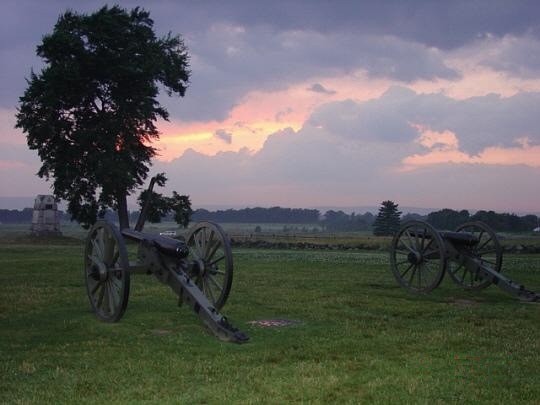
Gettysburg National Military Park
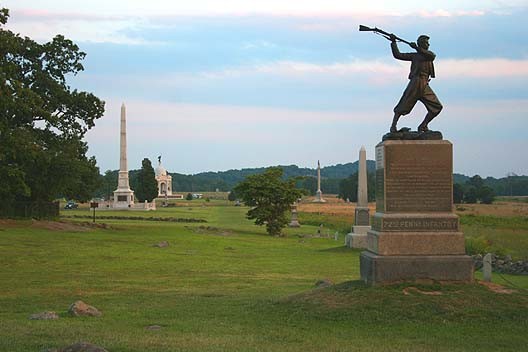
Entrance to the park in 1900
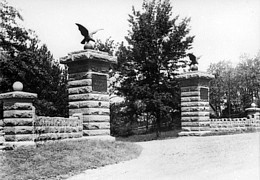
Surgery at Camp Letterman General Hospital
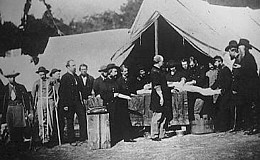
Corporal Francis A. Wallar of the Iron Brigade's 6th Wisconsin struggles with the 2nd Mississippi's color-bearer in the Unfinished Railroad Cut for possession of the Confederate regiment's flag on July 1, 1863.
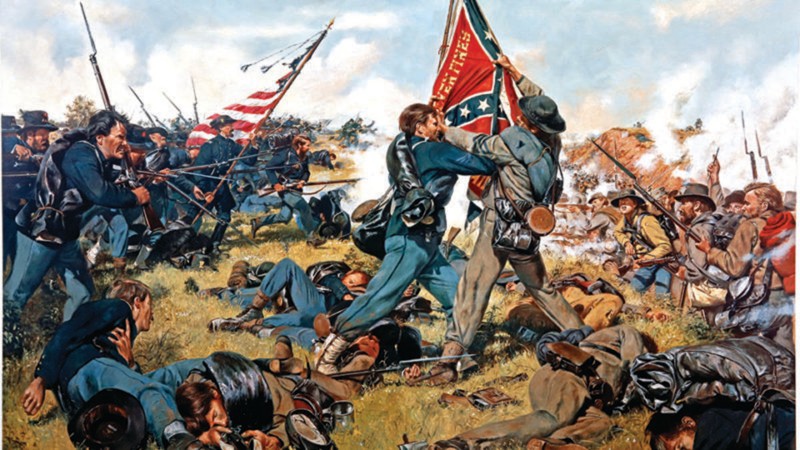
Abraham Lincoln giving the Gettysburg Address
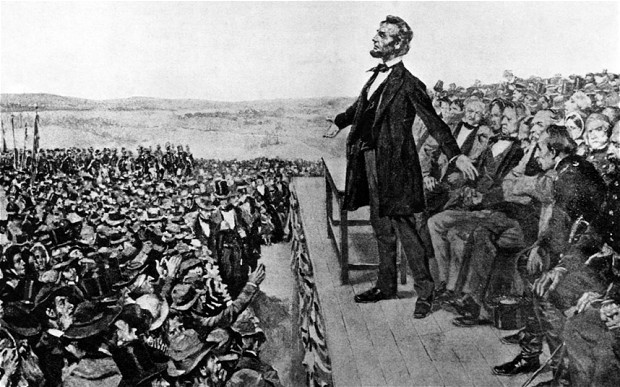
Copy of President Abraham Lincoln's Gettysburg Address
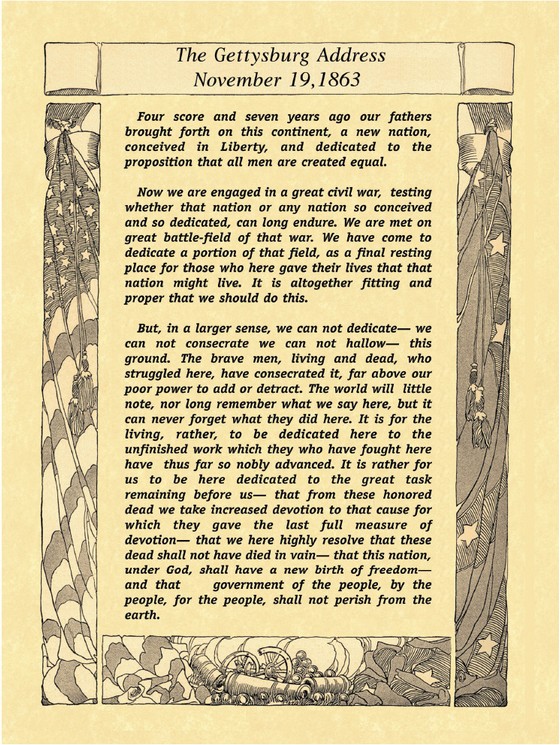
Gettysburg Address Memorial
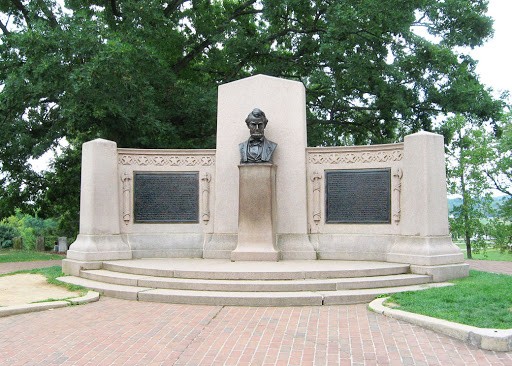
Backstory and Context
Text-to-speech Audio
In July of 1863, the Battle of Gettysburg encompassed 90,000 Union soldiers and 75,000 Confederate soldiers, resulting in one of the bloodiest battles of the Civil War. In June, Confederate General Robert E. Lee led the Army of Northern Virginia into central Pennsylvania for several reasons: to obtain supplies, to instigate antiwar activists in the North, and to gain military triumph on Northern soil that might persuade President Abraham Lincoln to call for peace and conclude the war via the destruction of a vital railroad bridge over the Susquehanna River at Harrisburg. When Lee learned Confederate forces had crossed the Potomac River, he sent all units to Gettysburg to avoid confrontation. Gettysburg, while not necessarily an important location during the Civil War, had over a dozen roads leading into the town, making it accessible for his troops to concentrate there.
On July 1, forces collided with Union Major General George Gordon Meade and the battle began, continuing into the second day. Lee attacked the Union army from both sides and had great success, but was overconfident and thought the center would be weakened due to Meade reinforcing the two flanks, therefore making the Union easy to defeat. On July 3, the third day of battle, Lee sent 13,00 of his soldiers, led by Major General George Pickett, to attack the center, but fewer than half of his soldiers returned. The failed attack later became known as “Pickett’s Charge.” The following day, Lee and his remaining troops retreated to Virginia, where Meade attempted to cut them off, but failed to do so before they recrossed the Potomac River.
The aftermath of the battle was brutal for the Confederacy. In total, the battle caused around 50-51,000 casualties. On the Union side, over 3,000 men were dead, 14,529 wounded, and 5,365 missing or captured. On the Confederate side, over 4,000 men were dead, 18,735 wounded, and 5,425 missing or captured. Due to the high number of casualties, it is referred to as the “High Water Mark of the Rebellion.” Distraught from the loss, General Robert E. Lee offered up his resignation as general but was refused that request. The South was demoralized after the loss and the North took full advantage in continuing to end the Civil War.
Afterward, churches, public buildings, hospitals, and even private homes were filled with wounded soldiers. The Camp Letterman General Hospital was temporarily established east of Gettysburg. There, a majority of both Union and Confederate soldiers were taken and treated by Union surgeons working with the U.S. Sanitary Commission and Christian Commission, before being moved to permanent hospitals in Philadelphia, Baltimore, and Washington. By January of 1864, the last patients were gone.
Residents of the area grew concerned with the terrible condition of soldiers' graves scattered over the battlefield and at hospital sites, and pleaded with Pennsylvania Governor Andrew Curtin for state support to buy a portion of the battlefield to be set aside as a final resting place for the defenders of the Union cause. Gettysburg lawyer David Wills was appointed the state agent to head the establishment of the new "Soldiers' National Cemetery,” which was designed by famous architect William Saunders. Removal of the Union dead to the cemetery began in the fall of 1863, but would not be completed until long after the cemetery grounds were dedicated on November 19, 1863.
The dedication ceremony prompted around 15,000 attendees, including prominent political figures, and featured orator Edward Everett, who gave a successful two-hour speech, and included solemn prayers, songs, and dirges to honor the men who died at Gettysburg. Yet, it was President Abraham Lincoln who provided the most notable words in his speech, that was just over two minutes long and fewer than 300 words, which became known as the Gettysburg Address, eulogizing the Union soldiers buried at Gettysburg and reminding those in attendance of their sacrifice for the Union cause, that they should renew their devotion "to the cause for which they gave the last full measure of devotion." There is speculation that Lincoln wrote his speech on the train ride to the memorial, and that some parts, such as the opening “four score and seven years ago,” are traced back to Bible scripture.
The Battle of Gettysburg, coinciding with the capture of Vicksburg on July 4, 1863, is known as a turning point in the Civil War. In 1864, the Gettysburg Battlefield Memorial Association was established to preserve portions of the battlefield. The following year, they transferred their holdings to the Federal government, which designated Gettysburg as a National Military Park. A commission of Civil War Veterans oversaw the park’s development as a memorial to both armies, before the administration transferred it to the Department of Interior, National Park Service in 1933, which still oversees it. People still visit the park to pay tribute to the men who gave their lives in battle, some stating "as soon as you enter the battlefields, whether you are spiritual or not, you can feel this immense sadness. You can just feel that there is something there. With 51,000 lives lost there in three days…I believe there are souls still there," (Blue Monday, comments of Battle of Gettysburg (Full Documentary).
Sources
- -http://www.nps.gov/gett/historyculture/index.htm -Editors, H. (2009, October 29). Battle of Gettysburg. Retrieved March 1, 2019, from https://www.history.com/topics/american-civil-war/battle-of-gettysburg
- OConnor, Jim, and John Mantha. What Was the Battle of Gettysburg?New York, NY: Scholastic Inc, 2016. (This is a simple book with an overview of the entire battle)
- Reardon, Carol. "Gettysburg, Battle of." The Oxford Encyclopedia of American Military and Diplomatic History, edited by Paul S. Boyer, Oxford University Press, Inc., 1st edition, 2013. Credo Reference, https://marshall.idm.oclc.org/login?url=https://search.credoreference.com/content/entry/oupomad/gettysburg_battle_of/0?institutionId=3309. Accessed 13 Mar. 2020.
- Lincoln, Abraham, and Greta Gard. "“The Gettysburg Address”" The Literature of War, edited by Thomas Riggs, Gale, 1st edition, 2012. Credo Reference, https://marshall.idm.oclc.org/login?url=https://search.credoreference.com/content/entry/galelow/the_gettysburg_address/0?institutionId=3309. Accessed 13 Mar. 2020.
- Wills, Garry. "Gettysburg Address." The Oxford Encyclopedia of American Military and Diplomatic History, edited by Paul S. Boyer, Oxford University Press, Inc., 1st edition, 2013. Credo Reference, https://marshall.idm.oclc.org/login?url=https://search.credoreference.com/content/entry/oupomad/gettysburg_address/0?institutionId=3309. Accessed 13 Mar. 2020.
- Mcpherson, James M., and James M. McPherson. "Gettysburg, Battle of." The Reader's Companion to Military History, edited by Robert Cowley, and Geoffrey Parker, Houghton Mifflin, 1st edition, 1996. Credo Reference, https://marshall.idm.oclc.org/login?url=https://search.credoreference.com/content/entry/rcmh/gettysburg_battle_of/0?institutionId=3309. Accessed 13 Mar. 2020.
- Gettysburg, American Battlefield Trust. Accessed September 8th 2020. https://www.battlefields.org/learn/civil-war/battles/gettysburg.
- The Battle of Gettysburg, National Park Service. Accessed September 8th 2020. https://www.nps.gov/gett/learn/historyculture/index.htm.
National Park Service
National Park Service
Library of Congress
https://www.google.com/url?sa=i&url=https%3A%2F%2Fwww.historynet.com%2F12-forgotten-heroes-of-gettysburg.htm&psig=AOvVaw0l-xI2FGvJ7CZf5Wg1cRHn&ust=1584191923721000&source=images&cd=vfe&ved=0CAIQjRxqFwoTCNDWlJ3Gl-gCFQAAAAAdAAAAABAD
https://www.google.com/url?sa=i&url=https%3A%2F%2Fwww.telegraph.co.uk%2Fnews%2Fworldnews%2Fnorthamerica%2Fusa%2F10459312%2F150-years-on-Abraham-Lincolns-Gettysburg-address-still-has-the-power-to-inspire.html&psig=AOvVaw0BDkULw3iz90oNGiJ813Q-&ust=1584191979739000&source=images&cd=vfe&ved=0CAIQjRxqFwoTCOjfqaXFl-gCFQAAAAAdAAAAABAD
Getty Images
https://www.google.com/url?sa=i&url=http%3A%2F%2Fgettysburg.stonesentinels.com%2Fother-monuments%2Flincolns-gettysburg-address-memorial%2F&psig=AOvVaw1N1EQozfP0Y8skCe76weEY&ust=1584192120628000&source=images&cd=vfe&ved=0CAIQjRxqFwoTCID2_dnFl-gCFQAAAAAdAAAAABAD
